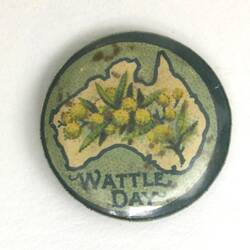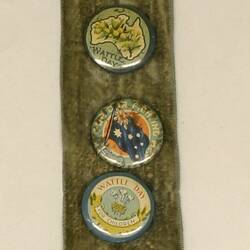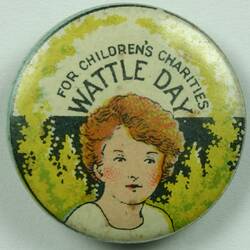Summary
Alternative Name(s): Button
'Wattle Day' badge, made circa 1914-1919.
The first 'national' Wattle Day was celebrated in Sydney, Melbourne and Adelaide on 1 September 1910. Wattle had become a symbol of Australia with the approach of Federation. It was particularly promoted by the Australian Natives' Association, established in Melbourne in 1871 as a non-partisan and non-sectarian friendly society for Australian-born, white men seeking to shape Australia's nationhood and identity. The ANA was a strong advocate for Federation and became an advocate for White Australia. It was a staunch supporter of trade protection and immigration restriction, and Prime Minister Alfred Deakin was a member. Public support for Wattle Day peaked during World War I, when it was a potent symbol of home for military personnel serving overseas, and a means of raising money for organisations such as the Red Cross. Beautifully designed Wattle Day badges as well as wattle sprigs were sold. The influence of Wattle Day waned as the 20th century progressed, but in 1992 the Governor-General declared 1 September National Wattle Day.
Physical Description
Circular badge with pale green background with a dark blue boarder. Features map of Australia in cream, filled with green and yellow sprigs of wattle. Underneath the image of Australia is dark blue text.
Significance
The Museum already holds a fair collection of fund-raising badges and some research has been done on their meaning and significance (see Supp. File 95.211) This acquisition allows us to add some additional examples, and also shows how a family's collection was stored after the War.
The movement to link nature and nationalism began to grow in the late nineteenth century, with the approach of Federation. Arbor, Bird and Wattle Days were founded. Unlike Empire Day, which seemed to subsume or ignore Australia's identity, these days helped to develop a sense of an Australian identity. Publications such as the Bulletin also supported the rural ideal, in contrast to the moral degeneracy of the city.
Of particular importance to the development of Wattle Day was the Australian Natives' Association, established in Melbourne in 1871 as a non-partisan and non-sectarian friendly society for Australian-born, white men seeking to shape Australia's nationhood and identity. The ANA was a strong advocate for Federation and became an advocate for White Australia. It was a staunch supporter of trade protection and immigration restriction, and Prime Minister Alfred Deakin was a member. The ANA was keen to find a national flower for Australia, like the thistle for the Scot and the shamrock for Ireland. It argued for the wattle, which was eventually chosen as the national floral emblem. The wattle could be worn by anyone, reminding people that Australia was an egalitarian, classless society. It was also a feminine symbol, presenting the new nation as a young woman.
In Victoria, spring excursions in search of wattle promoted Archibald James Campbell to establish the Wattle Club in 1899. By 1912 it had become the Wattle Day League charity.
Ironically, the destruction of wattle for Wattle Day displays and fund-raising sales reached such heights that farmers within an hour of Melboure locked their gates and wrote angry letters to newspapers. Ultimately, buttons bearing the images of wattle largely replaced actual wattle, and were widely used for fund-raising.
The influence of Wattle Day waned as the twentieth century progressed. Most states lost interest, but the Wattle Day League limped on in Victoria until the mid-1960s. In 1988 the idea of the wattle as a national flower was revived, and in 1992 the Governor-General declared 1 September as National Wattle Day.
The decline of Wattle Day appears to have had several causes. Foremost of these was the association of wattle with death. Children often died when it was blooming, of diseases such as diptheria and whooping cough. Wattle also symbolized the Anzacs and the battlefields of the Somme. Further, the expression 'blood on the wattle' from Henry Lawson's poem evoked a class or cultural struggle that betrayed the idea of an egalitarian symbol. Although this declined during wartime, in the post-war period the bloodied wattle began to appear again as a symbol of heroism of a mythical White Australia.
-Robin, Libby. 2002. Nationalising Nature: Wattle Days in Australia. Journal of Australian Studies. 73: 13-26 and 219-223. -D. Tout-Smith 18/9/2003.
More Information
-
Collecting Areas
-
Acquisition Information
Donation from Mrs Bronwyn Mitchell, 15 Feb 1994
-
Place & Date Used
-
Inscriptions
Text: 'WATTLE/DAY'.
-
Classification
-
Category
-
Discipline
-
Type of item
-
Overall Dimensions
2.2 cm (Width)
-
Keywords
Fundraising, Wars & Conflicts, Wattle Day, World War I, 1914-1918



